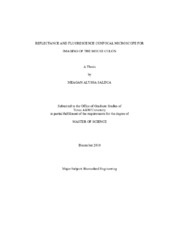| dc.description.abstract | Many Americans are afflicted with inflammation of the colon. They are also at a
higher risk of developing colon cancer. Confocal microscopy of bulk epithelial tissue has
the potential to provide information on tissue structural properties that may be lost in the
fixation and slicing procedures required for histopathology. Optical sectioning provides
images in three dimensions capturing the organizational structure of cells and colon
crypts throughout the entire colon. I have constructed a custom built fluorescence and
reflectance confocal microscope for imaging molecular and morphological changes
associated with development of inflammation in a mouse model.
A confocal microscope is a point scanning system that removes out of focus
light by placing a pinhole aperture in the conjugate image plane located in front of the
detector. We have two sources, 488 nm and 811 nm, for fluorescence and reflectance
imaging, respectively. A polygon scanning mirror and a galvanometer scanning mirror
allow for a variable scan rate between 8 and 15 fps. The lateral resolution of the system
is approximately 3 μm with an axial resolution of 6 μm and 4 μm for reflectance and
fluorescence mode, respectively.
As colon tissue becomes inflamed, there is a distinct change in the structure and
architecture of the tissue. The colon crypts are no longer uniform in size or distribution
throughout the tissue. Having a large field of view of 1mm2 allows for many colon
crypts to be visualized within a single frame. Histology was performed on the same
tissue imaged for the inflammatory study confirming the constructed confocal
microscope’s ability to characterize inflamed tissue and the potential use for guided
biopsy.
Mosaicing, or image tiling, is an imaging technique that stitches single frames
together to produce a much larger field of view. An extended frame with 1 mm x 2 cm
field of view is achieved within seconds. This extended frame would allow mosaicing of
the entire mouse colon much faster than conventional methods without loss of
resolution.
The acquired confocal images of colon tissue demonstrate the microscope’s
ability to resolve cell nuclei lining the colon crypts within a relatively large field of
view. | en |


